Development of Captive Breeding Techniques for Marine Ornamental Fish a Review
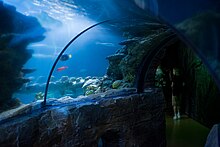
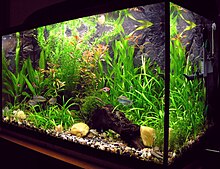
An aquarium (plural: aquariums or aquaria) is a vivarium of whatsoever size having at least one transparent side in which aquatic plants or animals are kept and displayed. Fishkeepers use aquaria to keep fish, invertebrates, amphibians, aquatic reptiles, such equally turtles, and aquatic plants. The term aquarium, coined past English naturalist Philip Henry Gosse, combines the Latin root aqua , significant 'h2o', with the suffix -arium , meaning 'a identify for relating to'.[1]
The aquarium principle was fully developed in 1850 past the chemist Robert Warington, who explained that plants added to water in a container would requite off plenty oxygen to support animals, so long every bit the numbers of animals did non grow too large.[2] The aquarium craze was launched in early Victorian England past Gosse, who created and stocked the first public aquarium at the London Zoo in 1853, and published the start manual, The Aquarium: An Unveiling of the Wonders of the Deep Bounding main in 1854.[two] Small aquariums are kept in the home by hobbyists. There are large public aquariums in many cities. Public aquariums keep fish and other aquatic animals in large tanks. A large aquarium may have otters, turtles, dolphins, sharks, and whales. Most aquarium tanks also have plants.[iii]
An aquarist owns fish or maintains an aquarium, typically constructed of glass or high-strength acrylic. Cuboid aquaria are too known every bit fish tanks or simply tanks, while bowl-shaped aquaria are also known every bit fish bowls. Size tin range from a pocket-sized glass bowl, a few liters in volume, to immense public aquaria of thousands of liters. Specialized equipment maintains appropriate water quality and other characteristics suitable for the aquarium's residents.
History and popularization [edit]

Antiquity [edit]
In 1369, the Hongwu Emperor of China established a porcelain company that produced large porcelain tubs for maintaining goldfish; over fourth dimension, people produced tubs that approached the shape of modern fish bowls.[four] Leonhard Baldner, who wrote Vogel-, Fisch- und Tierbuch (Bird, Fish, and Animal Book) in 1666, maintained weather loaches and newts.[five] It is sometimes held that the aquarium was invented by the Romans, who are said to have kept sea barbels in marble-and-glass tanks, only this is definitely not true.[half dozen]
Nineteenth century [edit]

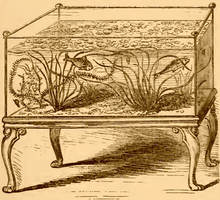
In 1832, Jeanne Villepreux-Power, a pioneering French marine biologist, became the commencement person to create aquaria for experimenting with aquatic organisms. In 1836, shortly after his invention of the Wardian case, Dr. Nathaniel Bagshaw Ward proposed to utilise his tanks for tropical animals. In 1841 he did so, though only with aquatic plants and toy fish. However, he before long housed real animals. In 1838, Félix Dujardin noted owning a saltwater aquarium, though he did non employ the term.[7] In 1846, Anne Thynne maintained stony corals and seaweed for almost 3 years, and was credited as the creator of the first balanced marine aquarium in London.[8] [9] English chemist Robert Warington experimented with a 13-gallon container, which contained goldfish, eelgrass, and snails, creating one of the starting time stable aquaria. The aquarium principle was fully developed by Warington, explaining that plants added to h2o in a container would give off plenty oxygen to support animals, so long as their numbers do not grow too large.[2] He published his findings in 1850 in the Chemical Society'south periodical.[10]

The Jardin zoologique at the Bois de Boulogne included an aquarium that housed both fresh and saltwater animals, 1860 in Paris.
The keeping of fish in an aquarium became a popular hobby and spread quickly. In the United kingdom, it became popular after ornate aquaria in bandage-fe frames were featured at the Groovy Exhibition of 1851. In 1853, the aquarium craze was launched in England by Philip Henry Gosse who created and stocked the first public aquarium in the London Zoo which came to exist known every bit the Fish Firm.[11] Gosse coined the word "aquarium", opting for this term (instead of "aquatic vivarium" or "aqua-vivarium") in 1854 in his book The Aquariums: An Unveiling of the Wonders of the Deep Water.[ii] In this volume, Gosse primarily discussed saltwater aquaria.[12] In the 1850s, the aquarium became a fad in the United kingdom of great britain and northern ireland.[thirteen] Tank designs and techniques for maintaining h2o quality were developed by Warington, later cooperating with Gosse until his critical review of the tank h2o composition. Edward Edwards adult these glass-fronted aquaria in his 1858 patent for a "dark-water-chamber gradient-back tank", with water slowly circulating to a reservoir beneath.[14]

"What an Aquarium Should Exist" – a humorous 1876 British engraving, manifestly showing Thomas Huxley dreaming about bounding main creatures
Germans before long rivaled the British in their involvement. In 1854, an anonymous writer had two manufactures published almost the saltwater aquaria of the United Kingdom: Dice Gartenlaube (The Garden Firm) entitled Der Ocean auf dem Tische (The Ocean on the Table). However, in 1856, Der Come across im Glase (The Lake in a Glass) was published, discussing freshwater aquaria, which were much easier to maintain in landlocked areas.[15] In 1862 William Alford Lloyd, then bankrupt because of the craze in England existence over, moved to Grindel Dammthor, Hamburg, to supervise the installation of the circulating system and tanks at the Hamburg Aquarium.[ citation needed ] During the 1870s, some of the showtime aquarist societies were appearing in Germany.[16] The United States soon followed. Published in 1858, Henry D. Butler's The Family Aquarium was one of the first books written in the United States solely about the aquarium.[17] Co-ordinate to the July issue of The Northward American Review of the aforementioned twelvemonth, William Stimson may have owned some of the first functional aquaria, and had as many as seven or eight.[xviii] The first aquarist society in the Us was founded in New York Metropolis in 1893, followed by others.[16] The New York Aquarium Journal, first published in October 1876, is considered to exist the world'southward first aquarium magazine.[19]
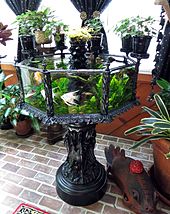
In the Victorian era in the United Kingdom, a common design for the abode aquarium was a glass front with the other sides made of wood (made watertight with a pitch coating). The bottom would be made of slate and heated from below.[22] More than advanced systems soon began to be introduced, along with tanks of glass in metal frames.[22] During the latter half of the 19th century, a variety of aquarium designs were explored, such as hanging the aquarium on a wall, mounting it as part of a window, or even combining it with a birdcage.[23]
Twentieth century [edit]
| | This department needs to be updated. (June 2019) |
Around 1908, the first mechanical aquarium air pump was invented, powered by running water, instead of electricity.[24] The introduction of the air pump into the hobby is considered by several historians of the hobby to be a pivotal moment in its development.[25]
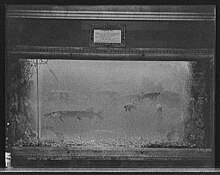
Aquaria became more than widely popular equally houses had an electricity supply later on World War I. Electricity allowed artificial lighting, as well as aeration, filtration, and heating of the h2o.[26] Initially, apprentice aquarists kept native fish (with the exception of goldfish); the availability of exotic species from overseas further increased the popularity of the aquarium.[27] Jugs fabricated from a variety of materials were used to import fish from overseas, with a bicycle pes pump for aeration.[28] Plastic shipping bags were introduced in the 1950s, making it easier to ship fish.[29] The eventual availability of air freight allowed fish to exist successfully imported from distant regions.[5] Popular publications started past Herbert R. Axelrod influenced many more hobbyists to starting time keeping fish.[30] In the 1960s, metal frames fabricated marine aquaria almost incommunicable due to corrosion, but the evolution of tar and silicone sealant allowed the first all-glass aquaria made by Martin Horowitz in Los Angeles, CA. The frames remained, however, though purely for artful reasons.[22]
Japan played an increasingly important part in shaping aquarium design in the latter part of the twentieth century, with the aquascaping designs of Takashi Amano influencing fishkeepers to treat dwelling house aquariums as aesthetically pleasing compositions, rather than simply as a fashion of displaying fish specimens.[31]
In the United States, as of 1996, aquarium keeping is the 2nd-most popular hobby afterwards stamp collecting.[32] In 1999, an estimated 9.6 million U.s. households owned an aquarium.[33] Figures from the 2005/2006 APPMA National Pet Owners Survey study that Americans own approximately 139 million freshwater fish and 9.6 one thousand thousand saltwater fish.[34] Estimates of the numbers of fish kept in aquaria in Germany suggest at least 36 million.[32] The hobby has the strongest following in Europe, Asia, and North America. In the United States, 40% of aquarists maintain two or more tanks.[35]
Over time, there has been an increasing appreciation of the usefulness of admission to an aquarium to provide potential stress reduction and comeback of mood in people observing aquatic life.[36] [37] Co-ordinate to the research of having an aquarium is many health benefits like reduce stress, blood pressure and heart rate improvement, meliorate quality sleep, reduce feet and pain, therapy of excited children, Alzheimer's therapy and improve productivity.
Design [edit]

An fourscore-litre dwelling aquarium
Materials [edit]
Glass [edit]
The very first modernistic aquarium made of glass was developed in the 19th century past Robert Warrington.[38] During the Victorian historic period, glass aquariums commonly had slate or steel bottoms, which immune them to exist heated underneath by an open-flame heat source. These aquariums had the glass panels fastened with metal frames and sealed with putty. Metallic-framed aquariums were all the same bachelor until the mid-1960s, when the modern, silicone-sealed way replaced them. Acrylic aquariums first became available to the public in the 1970s. Laminated glass is sometimes used, which combines the advantages of both drinking glass and acrylic.[39]

Today, almost aquaria consist of glass panes bonded together by 100% silicone sealant,[twoscore] with plastic frames attached to the upper and lower edges for decoration. The drinking glass aquarium is standard for sizes upwardly to nigh i,000 litres (260 US gal; 220 imp gal). Nonetheless, drinking glass is brittle and has very little give before fracturing, though generally the sealant fails offset.[39] Aquaria are made in a variety of shapes, such as cuboid, hexagonal, angled to fit in a corner (Fifty-shaped), and bow-front (the front side curves outwards).[41] Fish bowls are generally either fabricated of plastic or glass, and are either spherical or some other round configuration in shape.[ commendation needed ]
Glass aquaria accept been a popular choice for many dwelling and hobbyist aquarists for many years. Once silicone sealant became strong enough to ensure a long-term water-tight seal, it eliminated the need for a structural frame. In add-on to lower cost, drinking glass aquaria are more scratch resistant than acrylic. Although the price is one of the main considerations for aquarists when deciding which of these 2 types of aquaria to purchase, for very large tanks, the price divergence tends to disappear.[ citation needed ]
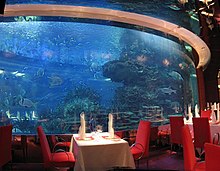
Acrylic [edit]
Acrylic aquaria are now the primary competitor with glass. Prior to the invention of UV stabilization, early on acrylic aquaria discolored over time with exposure to lite; this is no longer the case. Acrylic is generally stronger than drinking glass, weighs less, and provides a certain corporeality of temperature insulation. In colder climates or environments, it is easier to achieve and maintain a tropical temperature and requires less capacity from an aquarium heater.[42] Acrylic-soluble cements are used to straight fuse acrylic together.[39] Acrylic allows for the formation of unusual shapes, such every bit the hexagonal tank.[22] Acrylics are easier to scratch than glass, but unlike glass, scratches in acrylic can exist polished out.[39]
Other materials [edit]
Large aquaria might instead utilize stronger materials such as fiberglass-reinforced plastics. However, this material is not transparent.[39] Reinforced concrete is used for aquaria where weight and infinite are not factors. Physical must exist coated with a waterproof layer to forestall the water from breaking downwards the physical, as well every bit preventing contamination of the h2o by the concrete.[39]
Plywood tin can also be used when edifice aquaria. The benefits of using plywood include: lower construction costs, less weight, and better insulation. A pop positioning choice for plywood aquaria is keeping them in a wall. Here the use of plywood is hidden by sinking the aquarium inside the wall. Putting insulation between the 2 helps with the insulation of a heated tank.[43]
Styles [edit]

Objects used for aquariums include: coffee tables, sinks, gumball machines and even toilets.[44] [45] Another such example is the MacQuarium, an aquarium fabricated from the shell of an Apple Macintosh computer.[46] In recent years, elaborate custom-designed home aquariums costing hundreds of thousands of dollars have become condition symbols—according to The New York Times, "among people of ways, a dazzling aquarium is i of the last surefire means to impress their peers."[44]
Kreisel [edit]

A typical kreisel tank housing several moon jellyfish
A kreisel tank (kreisel being High german for "spinning superlative" or "gyroscope") is an aquarium shaped like a horizontal cylinder that is designed to hold frail animals such as jellyfish and newborn seahorses. These aquariums provide deadening, circular h2o flow with a blank minimum of interior hardware to prevent the inhabitants from condign injured past pumps or the tank itself.[47] The tank has no sharp angles around its sides and keeps the housed animals away from plumbing. H2o moving into the tank gives a gentle flow that keeps the inhabitants suspended. Water leaves the tank through a screen which prevents animals from being fatigued into the pump intake or overflow line.[ citation needed ]
At that place are several types of kreisel tanks. In a true kreisel, a circular tank has a circular, submerged chapeau. Pseudokreisels are "U" or semicircle shaped, usually without a lid.[48] Stretch kreisels are a "double gyre" kreisel pattern, where the tank length is at to the lowest degree twice the height. Using ii downwelling inlets on both sides of the tank lets gravity create 2 gyres in the tank. A unmarried downwelling inlet may be used in the centre every bit well. The top of a stretch kreisel may exist open or closed with a chapeau. There may too be screens about midway downwardly the sides of the tank, or at the pinnacle on the sides.[49] It is possible to combine these designs; a circular shaped tank is used without a lid or embrace, and the surface of the h2o acts as the continuation of circular flow.[fifty]
Biotope [edit]
Some other popular setup is the biotope aquarium.[51] A biotope aquarium is a recreation of a specific natural environment. Some of the most popular biotopes are the freshwater habitats of the Amazon and Rio Negro rivers, the African rift lake environments of Lake Malawi and Lake Tanganyika, and saltwater coral reefs of Australia, the Red Sea, and the Caribbean Sea. The fish, plants, substrate, rocks, wood, coral, and any other component of the brandish should completely match that of the local natural environment. It can exist a challenge to recreate such environments, and most "truthful" biotopes will only have a few (if not only one) species of fish and invertebrates.[ citation needed ]
Finally, an emerging concept for the home is that of a wall mounted aquarium,[52] some of which are displayed at the Living Fine art Marine Center[ citation needed ].
Aquarium size and volume [edit]

An aquarium can range from a modest glass bowl containing less than i litre (2.ane US pt) of water to immense public aquaria that firm entire ecosystems such as kelp forests. Relatively large home aquaria resist rapid fluctuations of temperature and pH, assuasive for greater organisation stability.[41] Beginner aquarists are advised to consider larger tanks to brainstorm with, as decision-making water parameters in smaller tanks tin testify difficult.[53]
Small-scale, unfiltered bowl-shaped aquaria are at present widely regarded as unsuitable for most fish. Advanced alternatives are at present available.[54] In order to keep water weather condition at suitable levels, aquariums should contain at least two forms of filtration: biological and mechanical. Chemic filtration should besides be considered under some circumstances for optimum water quality. Chemic filtration is frequently accomplished via activated carbon, to filter medications, tannins, and/or other known impurities from the water.[ citation needed ]
Reef aquaria nether 100 litres (26 Usa gal; 22 imp gal) have a special place in the aquarium hobby; these aquaria, termed nano reefs (when used in reefkeeping), accept a small water volume, nether 40 litres (11 United states gal; 9 imp gal).[55]

Practical limitations, most notably the weight of water (ane kilogram per litre (8.345 lb/U.Due south. gal; 10.022 lb/imp gal)) and internal water pressure (requiring thick glass siding) of a large aquarium, restrict most home aquaria to a maximum of effectually 1 cubic metre in volume (thousand Fifty, weighing 1,000 kg or 2,200 lb).[41] Some aquarists, however, have constructed aquaria of many thousands of litres.[56] [57]
Public aquariums and oceanariums designed for exhibition of large species or environments tin can be dramatically larger than any home aquarium. The Georgia Aquarium, for example, features an private aquarium of 6,300,000 US gallons (24,000,000 l).[58]
Nano aquariums [edit]
A new trend is to have very small aquariums, termed mini aquariums (less than 150 litres or 40 gallons) or nano aquariums (less than 75 litres or xx gallons). These can exist either freshwater or saltwater, and are intended to display a tiny only self-independent ecosystem.[59] [lx] [61]
Components [edit]
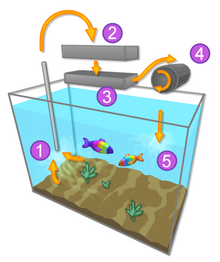
Filtration organisation in a typical aquarium: (1) intake, (2) mechanical filtration, (3) chemical filtration, (4) biological filtration medium, (v) outflow to tank
The typical hobbyist aquarium includes a filtration system, an bogus lighting organization, an air diffuser and pump, and a heater or chiller depending on the aquarium's inhabitants. Many aquaria incorporate a hood, containing the lights, to decrease evaporation and prevent fish from leaving the aquarium (and annihilation else from entering the aquarium).[41]
Combined biological and mechanical aquarium filtration systems are mutual. These either convert ammonia to nitrate (removing nitrogen at the expense of aquatic plants), or to sometimes remove phosphate. Filter media can house microbes that mediate nitrification. Filtration systems are sometimes the near circuitous component of home aquaria.[62]
Aquarium heaters combine a heating chemical element with a thermostat, allowing the aquarist to regulate water temperature at a level above that of the surrounding air, whereas coolers and chillers (refrigeration devices) are for utilise anywhere, such as cold water aquaria, where the ambience room temperature is above the desired tank temperature.[41] Thermometers used include glass alcohol thermometers, agglutinative external plastic strip thermometers, and bombardment-powered LCD thermometers.[41] In add-on, some aquarists apply air pumps fastened to airstones or h2o pumps to increase water circulation and supply acceptable gas exchange at the water surface. Wave-making devices have also been constructed to provide wave activeness.[39]
An aquarium's concrete characteristics course some other aspect of aquarium design. Size, lighting conditions, density of floating and rooted plants, placement of bog-woods, creation of caves or overhangs, type of substrate, and other factors (including an aquarium'due south positioning within a room) tin can all affect the behavior and survival of tank inhabitants.[ citation needed ]
An aquarium can be placed on an aquarium stand. Because of the weight of the aquarium, a stand up must exist strong besides as level. A tank that is not level may distort, leak, or cleft.[41] These are often built with cabinets to let storage, available in many styles to match room decor. Unproblematic metal tank stands are also available.[41] Near aquaria should be placed on polystyrene to cushion any irregularities on the underlying surface or the bottom of the tank itself that may cause cracks.[41] Notwithstanding, some tanks have an underframe making this unnecessary.[ citation needed ]
Another important consideration for aquariums is their electrical usage. Water is expensive to keep heated,[63] forth with the lights that many aquariums, peculiarly those with live plants accept. New aquarists should also pay close attending to their electric setup for their aquarium, taking care to setup ability connections with drip loops to prevent h2o from getting to outlets.[64]
Aquarium maintenance [edit]
Large volumes of water enable more stability in a tank by diluting effects from decease or contamination events that push button an aquarium abroad from equilibrium. The bigger the tank, the easier such a systemic shock is to absorb, because the effects of that event are diluted. For example, the death of the only fish in an 11-litre (3 United states of america gal; two imp gal) tank causes dramatic changes in the system, while the death of that same fish in a 400-litre (110 US gal; 88 imp gal) tank with many other fish in information technology represents only a pocket-size change. For this reason, hobbyists often favor larger tanks, every bit they require less attention.
Several nutrient cycles are important in the aquarium. Dissolved oxygen enters the system at the surface water-air interface. Similarly, carbon dioxide escapes the system into the air. The phosphate cycle is an important, although often overlooked, food bicycle. Sulfur, iron, and micronutrients also cycle through the system, entering as food and exiting as waste. Appropriate handling of the nitrogen cycle, along with supplying an adequately balanced nutrient supply and considered biological loading, is enough to keep these other nutrient cycles in approximate equilibrium.
An aquarium must exist maintained regularly to ensure that the fish are kept salubrious. Daily maintenance consists of checking the fish for signs of stress and disease.[65] Besides, aquarists must make sure that the h2o has a expert quality and it is not cloudy or foamy and the temperature of the water is appropriate for the particular species of fish that live in the aquarium.
Typical weekly maintenance includes changing around x–30% or more than of the water while cleaning the gravel, or other substrate if the aquarium has one; however some manage to avert this entirely by keeping it somewhat cocky-sufficient. A expert addiction is to remove the h2o being replaced past "vacuuming" the gravel with suitable implements, every bit this will eliminate uneaten foods and other residues that settle on the substrate.[66] In many areas tap h2o is non considered to exist rubber for fish to live in considering it contains chemicals that harm the fish. Tap water from those areas must be treated with a suitable water conditioner, such equally a product which removes chlorine and chloramine and neutralizes any heavy metals nowadays. The water conditions must be checked both in the tank and in the replacement h2o, to make certain they are suitable for the species.
Water weather [edit]
The solute content of h2o is possibly the most of import attribute of water conditions, as total dissolved solids and other constituents dramatically impact bones water chemistry, and therefore how organisms collaborate with their environment. Salt content, or salinity, is the most bones measure out of water conditions. An aquarium may accept freshwater (salinity below 500 parts per million), simulating a lake or river surround; brackish water (a common salt level of 500 to 30,000 PPM), simulating environments lying between fresh and salt, such as estuaries; and salt water or seawater (a salt level of xxx,000 to 40,000 PPM), simulating an sea environment. Rarely, higher salt concentrations are maintained in specialized tanks for raising alkali organisms.
Saltwater is ordinarily alkaline, while the pH (alkalinity or acidicity) of fresh water varies more. Hardness measures overall dissolved mineral content; difficult or soft h2o may exist preferred. Hard h2o is usually alkaline, while soft water is usually neutral to acidic.[67] Dissolved organic content and dissolved gases content are likewise of import factors.
Home aquarists typically use tap water supplied through their local water supply network to fill their tanks. Directly tap water cannot be used in localities that pipage chlorinated water. In the past, it was possible to "status" the water by only letting the water stand for a day or two, which allows the chlorine time to dissipate.[67] Nonetheless, chloramine is now used more than frequently and does not exit the water as readily. Water conditioners formulated to remove chlorine or chloramine are oftentimes all that is needed to make the water set up for aquarium use. Brackish or saltwater aquaria require the add-on of a commercially available mixture of salts and other minerals.

This aquarium features a heated tank and a glass-enclosed top for warmth during wintertime.
Some aquarists modify water's alkalinity, hardness, or dissolved content of organics and gases, earlier adding it to their aquaria. This can be accomplished past additives, such as sodium bicarbonate, to raise pH.[67] Some aquarists filter or purify their water through deionization or contrary osmosis prior to using information technology. In contrast, public aquaria with big h2o needs often locate themselves virtually a natural water source (such as a river, lake, or ocean) to reduce the level of handling. Some hobbyists use an algae scrubber to filter the h2o naturally.[68]
Water temperature determines the two about basic aquarium classifications: tropical versus common cold water. Almost fish and plant species tolerate just a limited temperature range; tropical aquaria, with an average temperature of about 25 °C (77 °F), are much more than mutual. Temperate or coldwater aquaria are for fish that are improve suited to a cooler environment. Temperature consistency is more important than range. Most organisms are not accustomed to sudden changes in temperatures, which tin can cause stupor and pb to disease.[67] H2o temperature can be regulated with a thermostat and heater (or cooler).
H2o movement can also be important in simulating a natural ecosystem. Aquarists may prefer anything from still water up to swift currents, depending on the aquarium's inhabitants. Water movement can be controlled via aeration from air pumps, powerheads, and conscientious pattern of internal water flow (such as location of filtration system points of inflow and outflow).
Nitrogen bike [edit]
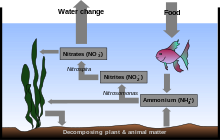
Of chief concern to the aquarist is direction of the waste product produced by an aquarium's inhabitants. Fish, invertebrates, fungi, and some leaner excrete nitrogen waste matter in the grade of ammonia (which converts to ammonium, in water) and must and then either laissez passer through the nitrogen bicycle or be removed by passing through zeolite.[69] Ammonia is besides produced through the decomposition of plant and animal thing, including fecal matter and other detritus. Nitrogen waste products become toxic to fish and other aquarium inhabitants at high concentrations.[67] [ page needed ] In the wild, the vast amount of water surrounding the fish dilutes ammonia and other waste materials. When fish are put into an aquarium, waste product can chop-chop accomplish toxic concentrations in the enclosed environment unless the tank is cycled to remove waste matter.[67] [ page needed ] [70]
The procedure [edit]
A well-balanced tank contains organisms that are able to metabolize the waste products of other aquarium residents, recreating a portion of the nitrogen bicycle. Bacteria known as nitrifiers (genus Nitrosomonas) metabolize nitrogen waste product. Nitrifying bacteria capture ammonia from the h2o and metabolize it to produce nitrite.[ citation needed ] Nitrite is toxic to fish in high concentrations. Some other type of bacteria (genus Nitrospira) converts nitrite into nitrate, a less toxic substance. (Nitrobacter leaner were previously believed to fill this role. While biologically they could theoretically make full the aforementioned niche equally Nitrospira, it has recently been institute that Nitrobacter are not nowadays in detectable levels in established aquaria, while Nitrospira are plentiful.)[ citation needed ] However, commercial products sold as kits to "jump start" the nitrogen cycle often still contain Nitrobacter.[ citation needed ]
Aquatic plants also eliminate nitrogen waste by metabolizing ammonia and nitrate. When plants metabolize nitrogen compounds, they remove nitrogen from the water by using it to build biomass that decays more slowly than ammonia-driven plankton already dissolved in the water. Some hobbyists also employ "anoxic filtration," which relies on leaner that alive in low-oxygen environments.[71]
Maintaining the nitrogen cycle [edit]

The nitrogen cycle in an aquarium is only a portion of the complete cycle: nitrogen must exist added to the system (usually through nutrient provided to the tank inhabitants), and nitrates accrue in the water at the end of the process, or become bound in the biomass of plants. The aquarium keeper must remove h2o once nitrate concentrations grow, or remove plants which take grown from the nitrates.
Hobbyist aquaria often do not have sufficient bacteria populations to fairly denitrify waste matter. This trouble is most often addressed through two filtration solutions: Activated carbon filters blot nitrogen compounds and other toxins, while biological filters provide a medium designed to enhance bacterial colonization. Activated carbon and other substances, such equally ammonia absorbing resins, finish working when their pores fill, and then these components have to exist replaced regularly.
New aquaria oft have problems associated with the nitrogen cycle due to insufficient benign bacteria.[72] Therefore, fresh water has to be matured before stocking them with fish. There are 3 basic approaches to this: the "fishless cycle", the "silent wheel" and "wearisome growth".
In a fishless bike, small amounts of ammonia are added to an unpopulated tank to feed the bacteria. During this process, ammonia, nitrite, and nitrate levels are tested to monitor progress. The "silent" cycle is basically nothing more than densely stocking the aquarium with fast-growing aquatic plants and relying on them to eat the nitrogen, assuasive the necessary bacterial populations time to develop. Co-ordinate to anecdotal reports, the plants can eat nitrogenous waste matter so efficiently that ammonia and nitrite level spikes seen in more traditional cycling methods are greatly reduced or disappear. "Tedious growth" entails slowly increasing the population of fish over a flow of vi to 8 weeks, giving bacteria colonies time to grow and stabilize with the increase in fish waste. This method is normally washed with a pocket-size starter population of hardier fish which tin can survive the ammonia and nitrite spikes, whether they are intended to be permanent residents or to exist traded out later for the desired occupants.
The largest bacterial populations are found in the filter, where there is high water flow and plentiful surface bachelor for their growth, so effective and efficient filtration is vital. Sometimes, a vigorous cleaning of the filter is enough to seriously disturb the biological balance of an aquarium. Therefore, it is recommended to rinse mechanical filters in an outside bucket of aquarium water to dislodge organic materials that contribute to nitrate problems, while preserving bacteria populations. Some other prophylactic practice consists of cleaning only half of the filter media during each service, or using two filters, merely 1 of which is cleaned at a fourth dimension.
Biological load [edit]

The biological load, or bioload, is a measure of the burden placed on the aquarium ecosystem past its inhabitants. High biological loading presents a more complicated tank ecology, which in turn ways that equilibrium is easier to upset. Several cardinal constraints on biological loading depend on aquarium size. The h2o'southward area limits oxygen intake. The bacteria population depends on the physical space they have available to colonize. Physically, only a limited size and number of plants and animals can fit into an aquarium while still providing room for move. Biologically, biological loading refers to the rate of biological decay in proportion to tank volume. Adding plants to an aquarium will sometimes help greatly with taking upward fish waste product as plant nutrients. Although an aquarium can be overloaded with fish, an excess of plants is unlikely to cause damage. Decaying constitute material, such every bit decaying found leaves, tin can add these nutrients dorsum into the aquarium if not promptly removed. The bioload is processed past the aquarium'southward biofilter filtration system.
Calculating chapters [edit]
Limiting factors include the oxygen availability and filtration processing. Aquarists have rules of thumb to guess the number of fish that can be kept in an aquarium. The examples below are for small freshwater fish; larger freshwater fishes and most marine fishes demand much more than generous allowances.
- 3 cm of adult fish length per 4 litres of water (i.e., a six cm-long fish would demand nearly 8 litres of water).[73]
- ane cm of adult fish length per 30 square centimetres of surface surface area.[74]
- i inch of adult fish length per US gallon of water.[73]
- 1 inch of adult fish length per 12 square inches of surface area.[74]
Experienced aquarists warn against applying these rules too strictly considering they practise not consider other important problems such equally growth rate, activeness level, social behaviour, filtration capacity, full biomass of plant life, and and so on.[75] It is better to apply the overall mass and size of a fish per gallon of water, than simply the length. This is because fish of unlike sizes produce quite differing amounts of waste matter. Establishing maximum capacity is often a thing of slowly adding fish and monitoring water quality over fourth dimension, post-obit a trial and error approach.
Other factors affecting capacity [edit]
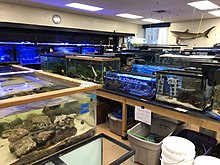
An academic aquarium at a university, using a variety of tank sizes and styles to intendance for unlike fish.
One variable is differences between fish. Smaller fish consume more oxygen per gram of trunk weight than larger fish. Labyrinth fish can exhale atmospheric oxygen and exercise not need as much surface area (however, some of these fish are territorial, and do non appreciate crowding). Barbs also require more surface expanse than tetras of comparable size.[67]
Oxygen exchange at the surface is an important constraint, and thus the surface area of the aquarium matters. Some aquarists claim that a deeper aquarium holds no more fish than a shallower aquarium with the aforementioned expanse. The chapters can exist improved by surface movement and water apportionment such as through aeration, which non just improves oxygen exchange, just also waste matter decomposition rates.[67]
Waste material density is another variable. Decomposition in solution consumes oxygen. Oxygen dissolves less readily in warmer water; this is a double-edged sword since warmer temperatures make fish more active, and so they consume more than oxygen.[67]
In addition to bioload/chemical considerations, aquarists also consider the mutual compatibility of the fish. For case, predatory fish are usually not kept with small-scale, passive species, and territorial fish are often unsuitable tankmates for shoaling species. Furthermore, fish tend to fare better if given tanks conducive to their size. That is, large fish need large tanks and pocket-size fish can practise well in smaller tanks. Lastly, the tank can go overcrowded without existence overstocked. In other words, the aquarium can be suitable with regard to filtration capacity, oxygen load, and water, yet still exist so crowded that the inhabitants are uncomfortable.[76]
For planted freshwater aquariums, it is besides important to maintain a balance between the duration and quality of calorie-free, the amount of plants, COtwo levels and nutrients. The amount of fish on the tank can also bear upon the nutrients levels. For a given amount of light, if in that location is insufficient number of plants or insufficient COtwo to back up the growth of those plants, so equally to swallow all the nutrients in the tank, the result would be algae growth. While there are fishes and invertebrates that could be introduced in the tank to clean up this algae, the ideal solution would exist to observe the optimal residuum betwixt the above-mentioned factors. Supplemental COtwo tin can be provided,[77] whose quantity has to be carefully regulated, as too much CO2 may impairment the fishes.[ original research? ]
Aquarium classifications [edit]
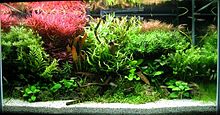
From the outdoor ponds and drinking glass jars of antiquity, mod aquaria have evolved into a wide range of specialized systems. Individual aquaria tin vary in size from a small basin large plenty for simply a unmarried minor fish, to the huge public aquaria that can simulate unabridged marine ecosystems.[ citation needed ]
I way to classify aquaria is past salinity. Freshwater aquaria are the most popular due to their lower cost.[78] More expensive and complex equipment is required to prepare up and maintain marine aquaria. Marine aquaria oftentimes feature a diverse range of invertebrates in add-on to species of fish.[62] [78] Brackish water aquaria combine elements of both marine and freshwater fishkeeping.[78] Fish kept in brackish h2o aquaria generally come from habitats with varying salinity, such equally mangrove swamps and estuaries. Subtypes exist within these types, such equally the reef aquarium, a typically smaller marine aquarium that houses coral.[78]
Another nomenclature is by temperature range. Many aquarists choose a tropical aquarium because tropical fish tend to be more colorful.[78] However, the coldwater aquarium is as well popular, which includes fish from temperate areas worldwide.[78]
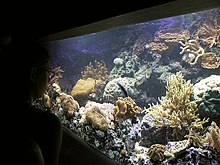
Aquaria may be grouped by their species selection. In a community tank, several non-aggressive species live peacefully. In these aquaria, the fish, invertebrates, and plants probably do not originate from the same geographic region, but tolerate like water conditions. Aggressive tanks, by contrast, house a limited number of species that can be aggressive toward other fish, or are able to withstand aggression well. Most aquarists maintaining marine tanks and tanks housing cichlids have to have species aggressiveness into account when stocking. Specimen tanks usually merely firm one fish species, forth with plants—sometimes those plant in the fish species' natural environs—and decorations simulating a natural ecosystem. This type is useful for fish that cannot coexist with other fish, such as the electric eel, as an extreme example. Some tanks of this sort are used just to house adults for convenance.[ citation needed ]
Biotope aquaria is another type based on species option. In information technology, an aquarist attempts to simulate a specific natural ecosystem, assembling fish, invertebrate species, plants, decorations and water weather condition all found in that ecosystem. Public aquaria often use this arroyo. Biotope aquaria simulates the experience of observing in the wild. It typically serves as the healthiest possible artificial environment for the tank's occupants.[ citation needed ]
Public aquaria [edit]

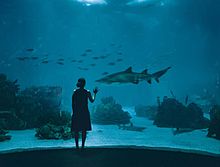
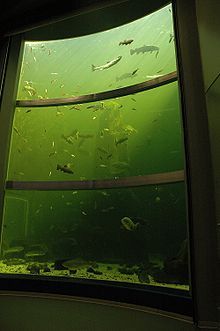
Nigh public aquarium facilities feature a number of smaller aquaria, besides those too big for abode aquarists. The largest tanks hold millions of gallons of h2o and can house large species, including sharks or beluga whales, which typically couldn't be housed properly in the home aquarium. Dolphinaria are specifically for dolphins. Aquatic and semiaquatic animals, including otters and penguins, may also be kept past public aquaria. Public aquaria may likewise exist included in larger establishments such as a marine mammal park or a marine park. These are very popular around the world, especially with a new emergence in the Eye East.
Virtual aquariums [edit]
A virtual aquarium is a figurer program which uses 3D graphics to reproduce an aquarium on a personal computer. The pond fish are rendered in existent time, while the background of the tank is normally static. Objects on the floor of the tank may be mapped in simple planes so that the fish may appear to swim both in front and backside them, but a relatively uncomplicated 3D map of the general shape of such objects may exist used to allow the lite and ripples on the surface of the water to cast realistic shadows. Bubbling and h2o noises are common for virtual aquariums, which are often used every bit screensavers.
The number of each type of fish tin can usually be selected, often including other animals like starfish, jellyfish, seahorses, and even body of water turtles. Most companies that produce virtual aquarium software also offer other types of fish for sale via Net download. Other objects found in an aquarium can likewise be added and rearranged on some software, like treasure chests and giant clams that open up and shut with air bubbles, or a bobbing diver. There are besides unremarkably features that allow the user to tap on the drinking glass or put nutrient in the top, both of which the fish volition react to. Some also have the ability to allow the user to edit fish and other objects to create new varieties.
Meet besides [edit]
- Listing of aquaria
- Association of Zoos and Aquariums (AZA
- Listing of aquarium diseases
- Listing of aquarium fish past scientific name
- Listing of stagnant aquarium fish species
- Listing of stagnant aquarium institute species
- List of freshwater aquarium amphibian species
- List of freshwater aquarium fish species
- List of freshwater aquarium invertebrate species
- Listing of freshwater aquarium plant species
- Listing of marine aquarium fish species
- List of marine aquarium invertebrate species
- Listing of marine aquarium plant species
- Vivarium
References [edit]
- ^ "Definition of aquarium". Merriam-Webster Online Dictionary. Archived from the original on iv April 2007. Retrieved 2007-04-03 .
- ^ a b c d Katherine C. Grier (2008) "Pets in America: A History". p. 53. University of North Carolina Press
- ^ Trump, Francis (October 11, 2017). "Aquariums is a water-filled tank in which fish swim almost". Jokpeme. Archived from the original on October 11, 2017. Retrieved October 11, 2017.
- ^ Brunner, Bernd (2003). The Body of water at Home. New York: Princeton Architectural Printing. pp. 21–22. ISBN1-56898-502-9.
- ^ a b Brunner, B: The Sea at Abode, folio 25
- ^ "Myth Roman Aq Klee". world wide web.wetwebmedia.com . Retrieved 2018-10-25 .
- ^ Brunner, B: The Ocean at Dwelling house, folio 35
- ^ "On the increase of Madrepores". Annals and Mag of Natural History. London: Taylor and Francis. three (29): 449–461. 1859.
- ^ Brunner, B: The Ocean at Home, pages 35–36
- ^ Brunner, B: The Sea at Home, page 36
- ^ Brunner, B: The Oceans at Dwelling house, pages 99
- ^ Brunner, B: The Ocean at Dwelling, folio 38
- ^ Brunner, B: The Ocean at Home, page 57
- ^ Alexander, Bob (November 2005). "The first Parlour Aquariums and the Victorian Aquarium Craze". History of parlour aquarium. parlouraquariums.org. Archived from the original on 22 July 2011. Retrieved 24 December 2010.
- ^ Brunner, B: The Body of water at Home, pages 60–61
- ^ a b Brunner, B: The Body of water at Home, page 75
- ^ Brunner, B: The Ocean at Home, page 69
- ^ Brunner, B: The Ocean at Domicile, page 71
- ^ Brunner, B: The Ocean at Home, pages 76–77
- ^ Pawlik, JR (2007). "Cast iron dazzler: an antiquarian J.W. Fiske Aquarium" (PDF). Tropical Fish Hobbyist. 55: 111–114.
- ^ "A J.W. Fiske cast-atomic number 26 aquarium". YouTube.
- ^ a b c d Sanford, Gina (1999). Aquarium Owner'south Guide. New York: DK Publishing. pp. 9–13. ISBN0-7894-4614-6.
- ^ Brunner, B: The Bounding main at Home, pages 86–89
- ^ "A History of the Hobby by Roger Vitko". Reefkeeping.com. Retrieved 2012-06-28 .
- ^ Whittall, Robin. "How Did It All Begin? The Roots Of Captive Fishkeeping From The Victorians' Perspective." 1999
- ^ Brunner, B: The Ocean at Dwelling house, page 93
- ^ Brunner, B: The Bounding main at Home, page 78
- ^ Brunner, B: The Body of water at Home, pages 82–83
- ^ Brunner, B: The Ocean at Home, page 82
- ^ Fromson, Daniel (31 December 2017). "Herbert R. Axelrod, a Hustler who Built a Fortune on a Fish Tale". The New York Times Magazine. pp. 43–44.
- ^ Axelrod, Herbert R., Warren E. Burgess, Neal Pronek, Glen Southward. Axelrod and David Due east. Boruchowitz (1998), Aquarium Fishes of the World, Neptune Urban center, N.J.: T.F.H. Publications, p. 718, ISBN 0-7938-0493-0.
- ^ a b Riehl, Rüdiger. Editor.; Baensch, HA (1996). Aquarium Atlas (5th ed.). Germany: Tetra Press. ISBN3-88244-050-iii.
- ^ Emerson, Jim (1999-08-01). "Aquarium Hobbyists". directmag.com. Archived from the original on 12 October 2004.
- ^ "National Pet Owners Survey". American Pet Products Manufacturers Association. 2005. Archived from the original on 6 Apr 2007. Retrieved 2007-05-02 .
- ^ "What is an Aquarist And How to Go 1". aquarist.
- ^ Mark Kinver (30 July 2015). "Aquariums 'deliver significant wellness benefits'". BBC News . Retrieved 28 July 2018.
- ^ Cracknell, Deborah; White, Mathew P; Pahl, Sabine; Nichols, Wallace J; Depledge, Michael H (2016). "Marine Biota and Psychological Well-Existence". Environment and Behavior. 48 (x): 1242–1269. doi:ten.1177/0013916515597512. PMC5081108. PMID 27818525.
- ^ "History of Fish Tank Materials". Archived from the original on 14 May 2010. Retrieved 2010-05-28 .
- ^ a b c d east f g Adey, Walter H.; Loveland, Karen (1991). Dynamic Aquaria. San Diego: Academic Printing. ISBN0-12-043792-nine.
- ^ Strohmeyer, Carl (1 January 2019). "Aquarium Silicone, Tank Repair, Applications, DIY, How To Apply". Aquarium Answers.
- ^ a b c d e f thou h i Sanford, Gina (1999). Aquarium Owner's Guide. New York: DK Publishing. pp. 162–169. ISBN0-7894-4614-6.
- ^ Crosswell, Tom. "Benefits of Acrylic for Home Aquariums". reef-one.com. Archived from the original on 2009-03-09. Retrieved 2009-05-ten .
- ^ liquid. "Characteristic Article: Building a Plywood Aquarium". Retrieved 2017-12-x .
- ^ a b Kingson, Jennifer A. (Baronial 19, 2010). "The Six-Figure Fish Tank Catches On". The New York Times. p. D1. Archived from the original on September 6, 2011. Retrieved Baronial 22, 2010.
- ^ "Archetype Gumball Motorcar Fishbowl Aquarium – Fun Unique One Fish Habitat Kit". Amazon . Retrieved five October 2014.
- ^ Ihnatko, Andy (1992). "The Original MacQuarium". Archived from the original on 2008-08-12. Retrieved 2007-04-04 .
- ^ Blundell, Adam (December 2004). "Delicatessen Part I: Creating a organisation for rare and delicate animals". Avant-garde Aquarist. Vol. three. Pomacanthus Publications, LLC. Archived from the original on 26 May 2007. Retrieved 2007-04-04 .
- ^ Wrobel, Dave. "Convict Jellies: Keeping Jellies in an Aquarium". The Jellies Zone. Archived from the original on 10 April 2007. Retrieved 2007-04-04 .
- ^ Raskoff, Kevin A.; Sommer, Freya A.; Hamner, William M.; Cantankerous, Katrina M. (February 2003). "Collection and culture techniques for gelled zooplankton". Biological Bulletin. 204 (1): 68–80. doi:10.2307/1543497. JSTOR 1543497. PMID 12588746. S2CID 22389317.
- ^ "How to Start a Jellyfish Tank: 12 steps (with pictures)". wikiHow. 2012-06-10. Retrieved 2012-06-28 .
- ^ "Biotope Aquarium". aquariumbase.com. 25 August 2016.
- ^ "Wall Mounted Aquarium". Retrieved July 13, 2014.
- ^ "Beginner'due south Guide to Set Up a Freshwater Aquarium". SmartAquariumGuide. 2018-10-05. Retrieved 2022-01-31 .
- ^ Crosswell, Tom. "Advanced filtered bowl aquariums – biOrb Aquariums". reef-ane.com. Archived from the original on 2009-07-03. Retrieved 2009-05-10 .
- ^ Reef Hobbyist Magazine, pp. 42–46, Q2 2013
- ^ Salvatori, Joe. "Building a 1700 gallon Shark Tank". Cichlid-Forum.com. Archived from the original on 5 April 2007. Retrieved 2007-04-03 .
- ^ "Building My 50,000 Gallon Monster Mega Tank". MonsterFishKeepers.com. 2005-10-30. Archived from the original on 24 April 2007. Retrieved 2007-04-04 .
- ^ "How the Georgia Aquarium Works". HowStuffWorks. 2005-12-28. Retrieved 2022-01-31 .
- ^ Boruchowitz, David E.; Herndal, Jay F. (2008). Mini Aquariums . T.F.H. Publications. ISBN978-0793805730.
nano aquarium.
- ^ Denaro, Marking; O'Leary, Rachel (2014). The 101 Best Freshwater Nano Species. T.F.H. Publications. ISBN978-0982026250.
- ^ Brightwell, Chris (2011). The Nano-Reef Handbook. T.F.H. Publications. ISBN978-0793807178.
- ^ a b Dakin, Nick (1992). The Macmillan book of the Marine Aquarium . New York: Macmillan Publishing Company. ISBN0-02-897108-half-dozen.
- ^ "The Cost of Running a Fish Tank – The Mandarin Garden". Retrieved 2020-12-11 .
- ^ freshwatercentral (2020-12-11). "How To Choice Supplies For Your 40 Gallon Aquarium". Freshwater Central . Retrieved 2020-12-xi .
- ^ "A Preventative Maintenance Schedule". Archived from the original on 25 May 2010. Retrieved 2010-05-28 .
- ^ "Aquarium Maintenance Tips". Retrieved 2010-05-28 .
- ^ a b c d e f one thousand h i Axelrod, Herbert, R. (1996). Exotic Tropical Fishes. T.F.H. Publications. ISBN0-87666-543-ane.
- ^ "Algae Scrubbers". algaescrubber.cyberspace.
- ^ Monks, Neale. "Aquarium Filter Maintenance". Fish Channel. BowTie, Inc. Archived from the original on 23 Oct 2012.
- ^ "Agreement Nitrogen Wheel In Aquarium". Tankquarium. 11 June 2021.
- ^ "Anoxic Filtration".
- ^ Kostich, James M. (2005). "New Tank Syndrome". Aquatics Unlimited. Archived from the original on x May 2008.
- ^ a b Baensch, Ulrich (1983). Tropical Aquarium Fish. Tetra. ISBN3-89356-131-5.
- ^ a b Scott, Peter (1996). The Complete Aquarium . Dorling Kindersley. ISBN0-7513-0427-ane.
- ^ Chris Andrews; Adrian Exell; Neville Carrington (1988). The Interpet Manual of Fish Health. Salamander Books. ISBN0-86101-368-9.
- ^ "MOA's: How Many Fish?, Stocking Freshwater Aquariums". google.com.
- ^ "CO2 carbon and liquid carbon in planted aquariums". 12 December 2018.
- ^ a b c d east f Sanford, Gina (1999). Aquarium Possessor'southward Guide. New York: DK Publishing. pp. 180–199. ISBN0-7894-4614-6.
External links [edit]
| | Wikimedia Commons has media related to Aquariums. |
- Aquarium at Curlie
- The Aquarium Wiki
- Ernest Ingersoll (1920). . Encyclopedia Americana.
Source: https://en.wikipedia.org/wiki/Aquarium
0 Response to "Development of Captive Breeding Techniques for Marine Ornamental Fish a Review"
Post a Comment